Spinus (genus)
Spinus is a genus of passerine birds in the finch family. It contains the North and South American siskins and goldfinches, as well as two Old World species. The genus name is from the Ancient Greek σπίνος spínos, a name for a now-unidentifiable bird.[1]
| Spinus | |
|---|---|
| American goldfinch (Spinus tristis) | |
| Scientific classification | |
| Kingdom: | Animalia |
| Phylum: | Chordata |
| Class: | Aves |
| Order: | Passeriformes |
| Family: | Fringillidae |
| Subfamily: | Carduelinae |
| Genus: | Spinus Koch, 1816 |
| Species | |
|
See text | |
All of the species in the genus, except for the Tibetan serin, were formerly included in the genus Carduelis. They were moved to the resurrected genus Spinus based on phylogenetic studies of mitochondrial and nuclear DNA sequences.[2][3][4] The Tibetan serin was formerly placed in the genus Serinus. The Eurasian siskin and the Tibetan serin are the only species from the Old World included in the group.[2]
The genus Spinus was introduced in 1816 by the German naturalist Carl Ludwig Koch with the Eurasian siskin (Spinus spinus) as the type species.[5][6]
Species
The genus contains 20 species:[2]
| Image | Common Name | Scientific name | Distribution |
|---|---|---|---|
 | Tibetan serin | Spinus thibetanus | Bhutan, China, India, Myanmar, and Nepal. |
.jpg) | American goldfinch | Spinus tristis | mid-Alberta to North Carolina during the breeding season, and from just south of the Canada–United States border to Mexico during the winter |
 | Lawrence's goldfinch | Spinus lawrencei | California and Baja California and winters in the southwestern United States and northern Mexico |
_(6548617653).jpg) | Lesser goldfinch | Spinus psaltria | southwestern United States (near the coast, as far north as extreme southwestern Washington) to Venezuela and Peru |
.jpg) | Eurasian siskin | Spinus spinus | Eurasia and the north of Africa |
 | Antillean siskin | Spinus dominicensis | Hispaniola (Haiti and the Dominican Republic) |
 | Pine siskin | Spinus pinus | Canada, Alaska and, to a more variable degree, across the western mountains and northern parts of the United States |
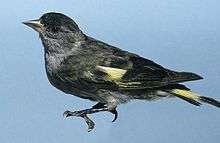 | Black-capped siskin | Spinus atriceps | Guatemala and Mexico |
.jpg) | Black-headed siskin | Spinus notata | Belize, El Salvador, Guatemala, Honduras, Mexico, and Nicaragua |
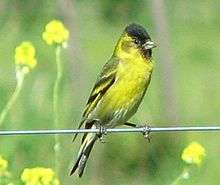 | Black-chinned siskin | Spinus barbata | Argentina, Chile and the Falkland Islands |
.jpg) | Yellow-bellied siskin | Spinus xanthogastra | Costa Rica south to southern Ecuador, central Bolivia and the highlands of northwestern Venezuela |
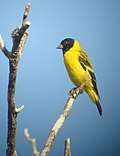 | Olivaceous siskin | Spinus olivacea | northern Peru to La Paz and Cochabamba in Bolivia and to southeastern Ecuador, and has also been observed east of the Andes near Santa Cruz de la Sierra in Bolivia |
.jpg) | Hooded siskin | Spinus magellanica | central Argentina north to central Brazil |
| Saffron siskin | Spinus siemiradzkii | Ecuador and Peru | |
| Yellow-faced siskin | Spinus yarrellii | Brazil and Venezuela | |
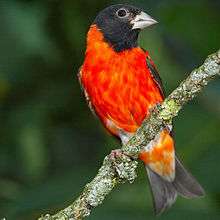 | Red siskin | Spinus cucullata | northern Colombia and northern Venezuela |
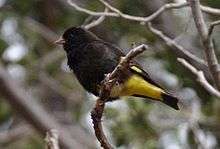 | Black siskin | Spinus atrata | Argentina, Bolivia, Chile, and Peru |
| Yellow-rumped siskin | Spinus uropygialis | Argentina, Bolivia, Chile, and Peru | |
| Thick-billed siskin | Spinus crassirostris | Argentina, Bolivia, Chile, and Peru | |
_-_Flickr_-_Alejandro_Bayer_(2).jpg) | Andean siskin | Spinus spinescens | Colombia, Ecuador, and Venezuela |
References
| Wikimedia Commons has media related to Spinus. |
- Jobling, James A. (2010). The Helm Dictionary of Scientific Bird Names. London, United Kingdom: Christopher Helm. p. 362. ISBN 978-1-4081-2501-4.
- Gill, Frank; Donsker, David (eds.). "Finches, euphonias". World Bird List Version 5.2. International Ornithologists' Union. Retrieved 5 June 2015.
- Zuccon, Dario; Prŷs-Jones, Robert; Rasmussen, Pamela C.; Ericson, Per G.P. (2012). "The phylogenetic relationships and generic limits of finches (Fringillidae)" (PDF). Molecular Phylogenetics and Evolution. 62 (2): 581–596. doi:10.1016/j.ympev.2011.10.002. PMID 22023825.
- Nguembock, B.; Fjeldså, J.; Couloux, A.; Pasquet, E. (2009). "Molecular phylogeny of Carduelinae (Aves, Passeriformes, Fringillidae) proves polyphyletic origin of the genera Serinus and Carduelis and suggests redefined generic limits". Molecular Phylogenetics and Evolution. 51 (2): 169–181. doi:10.1016/j.ympev.2008.10.022. PMID 19027082.
- Koch, Carl Ludwig (1816). System der baierischen Zoologie, Volume 1 (in German). Nürnberg. p. 232.
- Paynter, Raymond A. Jr, ed. (1968). Check-list of Birds of the World. Volume 14. Cambridge, Massachusetts: Museum of Comparative Zoology. p. 234.